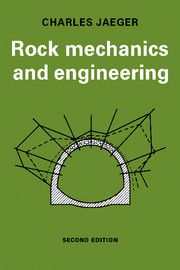Book contents
- Frontmatter
- Contents
- Preface
- Preface to the first edition
- Part 1 Introduction to rock mechanics
- Part 2 Rock material and rock masses
- Part 3 Rock mechanics and engineering
- Part 4 Case histories
- 12 Dam foundations and tunnelling
- 13 Incidents, accidents, dam disasters
- 14 The Vajont rock slide
- 15 Two examples of rock slopes supported with cables
- 16 Three examples of large underground hydro-power stations
- References
- Appendix 1 Comments on the bibliography
- Appendix 2 Measurement conversion tables
- Appendix 3 Table of geological formations and earth history
- Appendix 4 Some petrographic properties of rocks
- Author Index
- Index of geographical names, dam sites, reservoirs, tunnels and caverns
- Subject Index
12 - Dam foundations and tunnelling
Published online by Cambridge University Press: 04 August 2010
- Frontmatter
- Contents
- Preface
- Preface to the first edition
- Part 1 Introduction to rock mechanics
- Part 2 Rock material and rock masses
- Part 3 Rock mechanics and engineering
- Part 4 Case histories
- 12 Dam foundations and tunnelling
- 13 Incidents, accidents, dam disasters
- 14 The Vajont rock slide
- 15 Two examples of rock slopes supported with cables
- 16 Three examples of large underground hydro-power stations
- References
- Appendix 1 Comments on the bibliography
- Appendix 2 Measurement conversion tables
- Appendix 3 Table of geological formations and earth history
- Appendix 4 Some petrographic properties of rocks
- Author Index
- Index of geographical names, dam sites, reservoirs, tunnels and caverns
- Subject Index
Summary
Examples of particular rock engineering problems have been given in the previous chapters. The following details are taken from authoritative publications. They supplement the information given in parts two and three. It is interesting to note the methods responsible engineers have, in particular cases, employed to test rock materials and rock masses and how they have interpreted the results.
Rock mechanics for Karadj dam
Description of the project
The Karadj dam is located on the Karadj river, approximately 25 miles from the city of Teheran (Iran). The project will assure adequate and reliable supplies of municipal and industrial water to the capital of Iran. A secondary benefit of the project is hydroelectric peaking capacity.
The drainage area is 764 km2; the average annual run-off at the dam site is estimated at 472 × 106 m3; the maximum recorded flow is 350 m3/s and the spillway design flood is 1450 m3/s. The live storage capacity is 172 × 106 m3. There is a small regulating capacity of 0·6 × 106 m3 on the downstream side of the dam. The additional annual water supply available because of storage is estimated at 115·6 × 106 m3. The main dam is a double-curvature, thin concrete arch. It has a maximum height of 180 m and a crest length of 390 m. The horizontal circular arches have an approximately constant central angle. The radii of the arch centre lines vary from a minimum of 74 m at an elevation of 1612 m to a maximum of 201 m at elevation 1770 m (roadway level).
- Type
- Chapter
- Information
- Rock Mechanics and Engineering , pp. 359 - 378Publisher: Cambridge University PressPrint publication year: 1979



